L04 Nucleic Acid
一、The Nature of Nucleic Acids
The function of nucleotides:
- Genetic Material: DNA replication; Transcription; Translation
- Biological catalysts: enzymatic activity; Ribozyme
Structure of the nucleotides
1. Nucleic acids are polymers
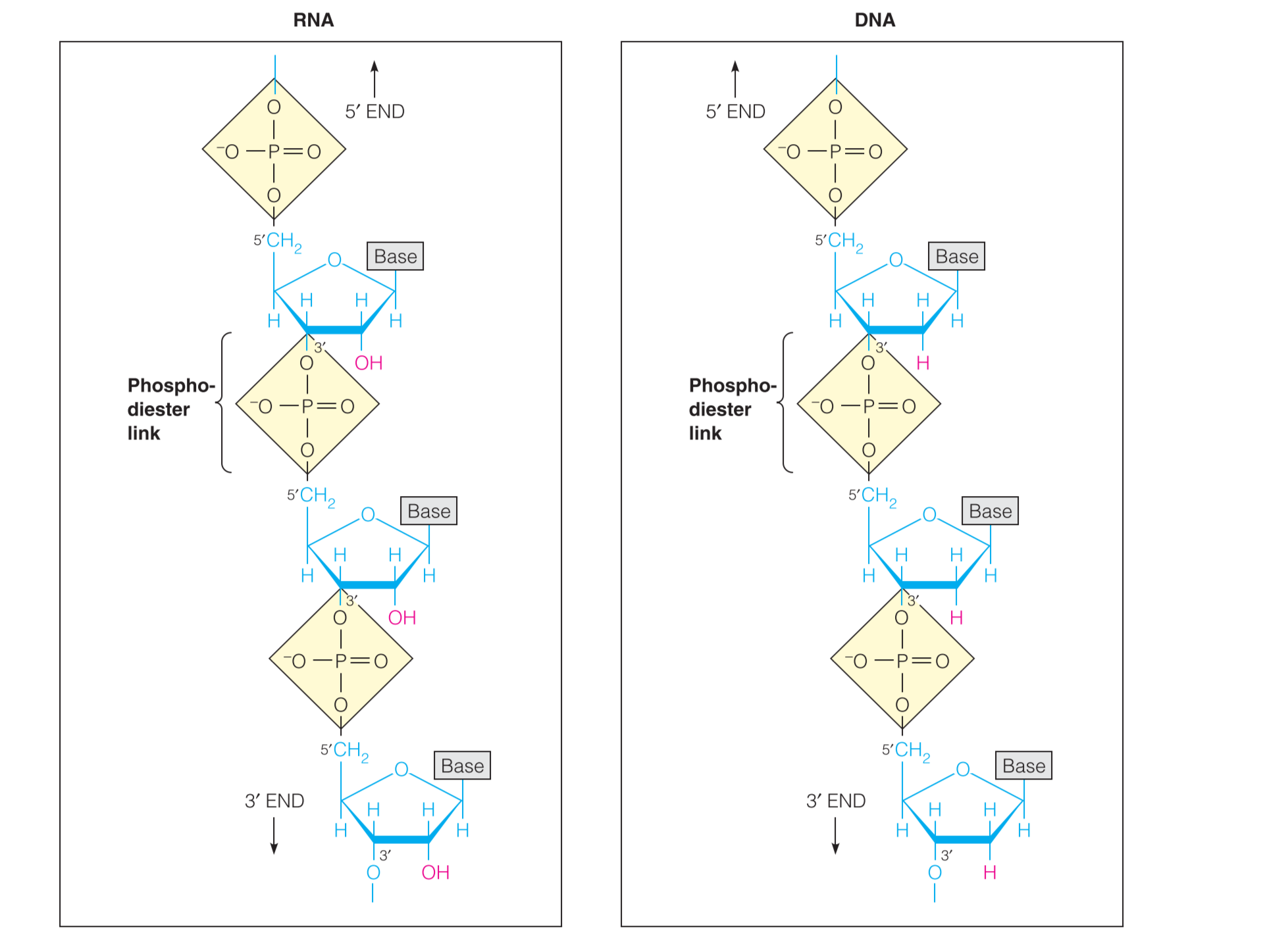
Miescher discovered DNA, deoxyribonucleic acid, and the other major form is RNA, ribonucleic acid.
2. Basic structures of nucleotides
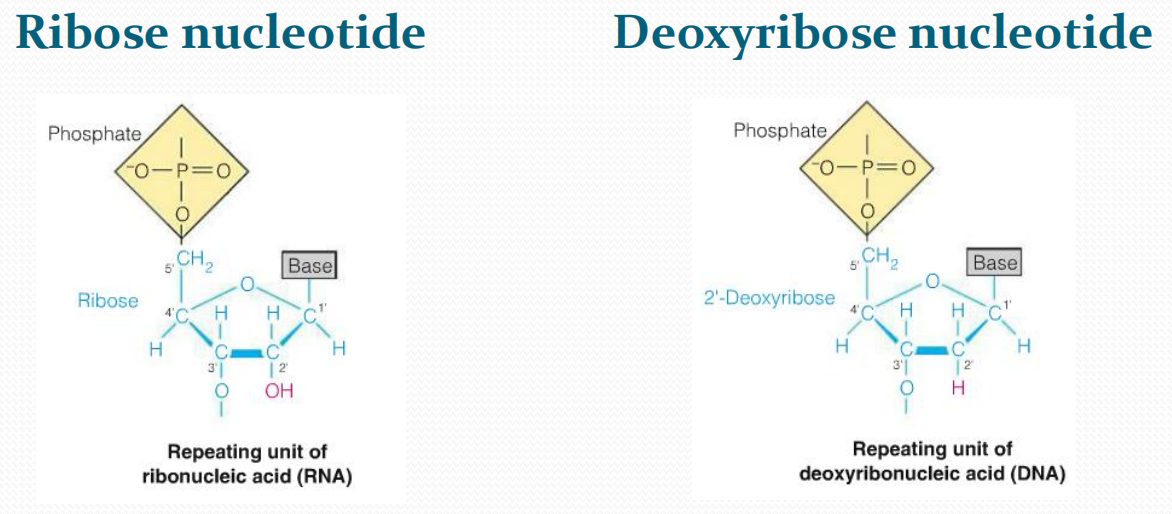
Sugar: Pentose
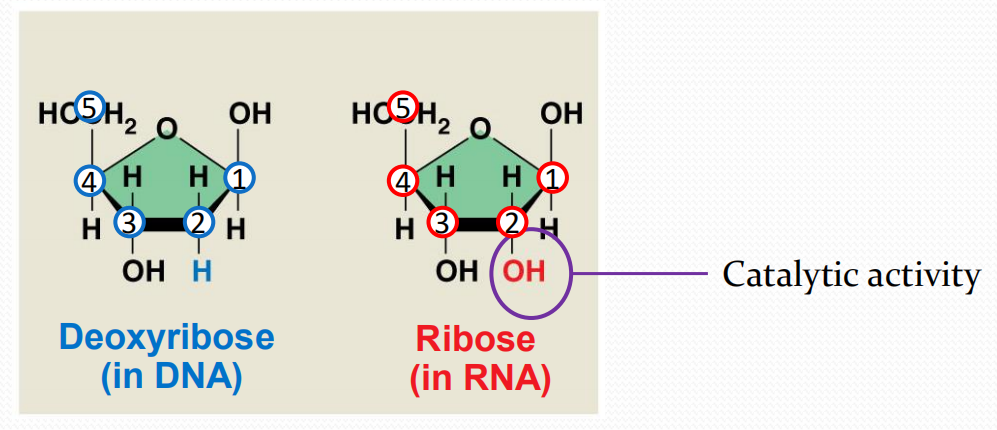
Bases: Pyrimidines and Purines
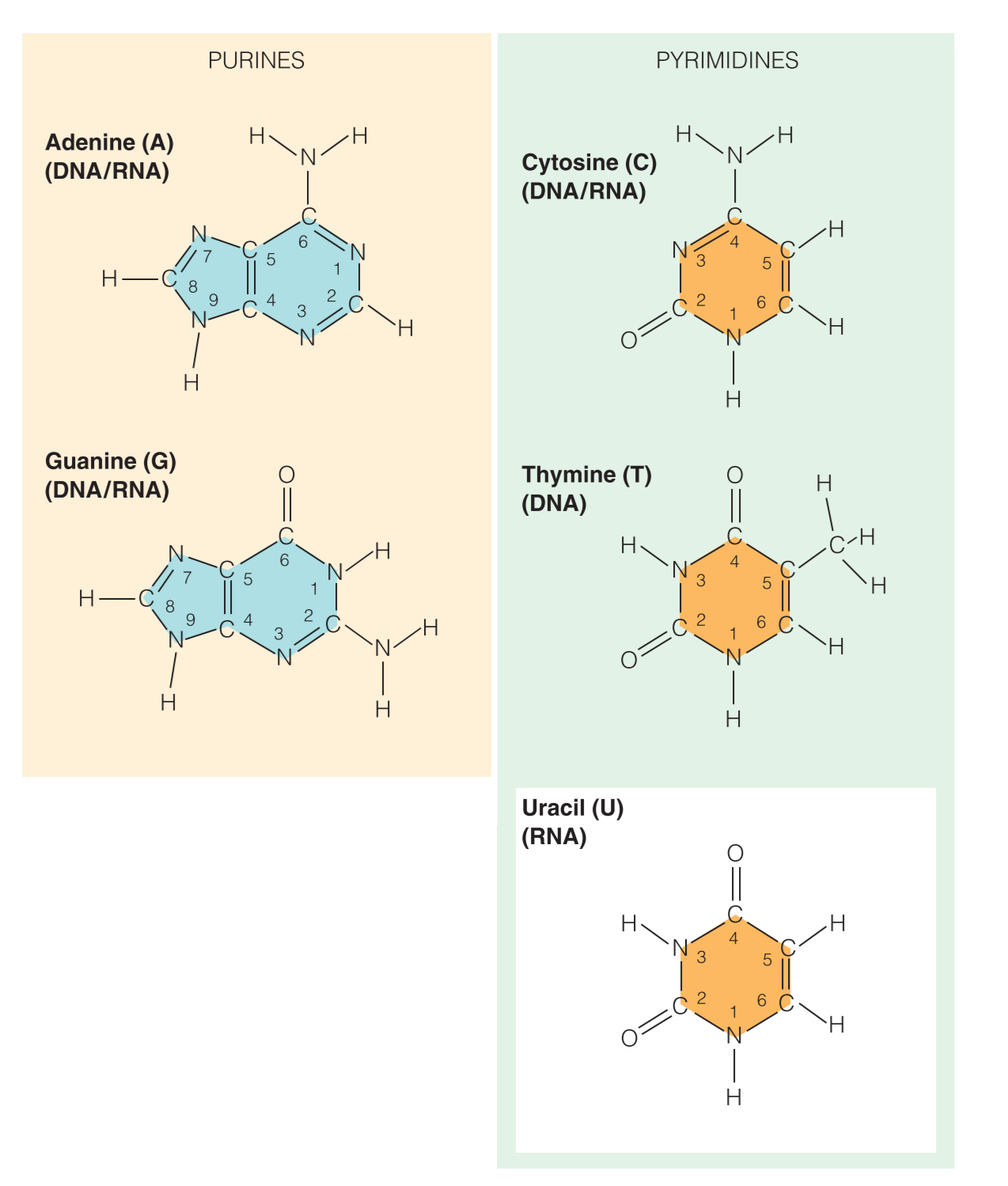
碱基与五碳糖通过glycosidic bond(糖苷键)相连.
碱基的$C_1$链接pentose的$C_{5’}$.
Nucleoside(核苷) and Nucleotide(核苷酸)
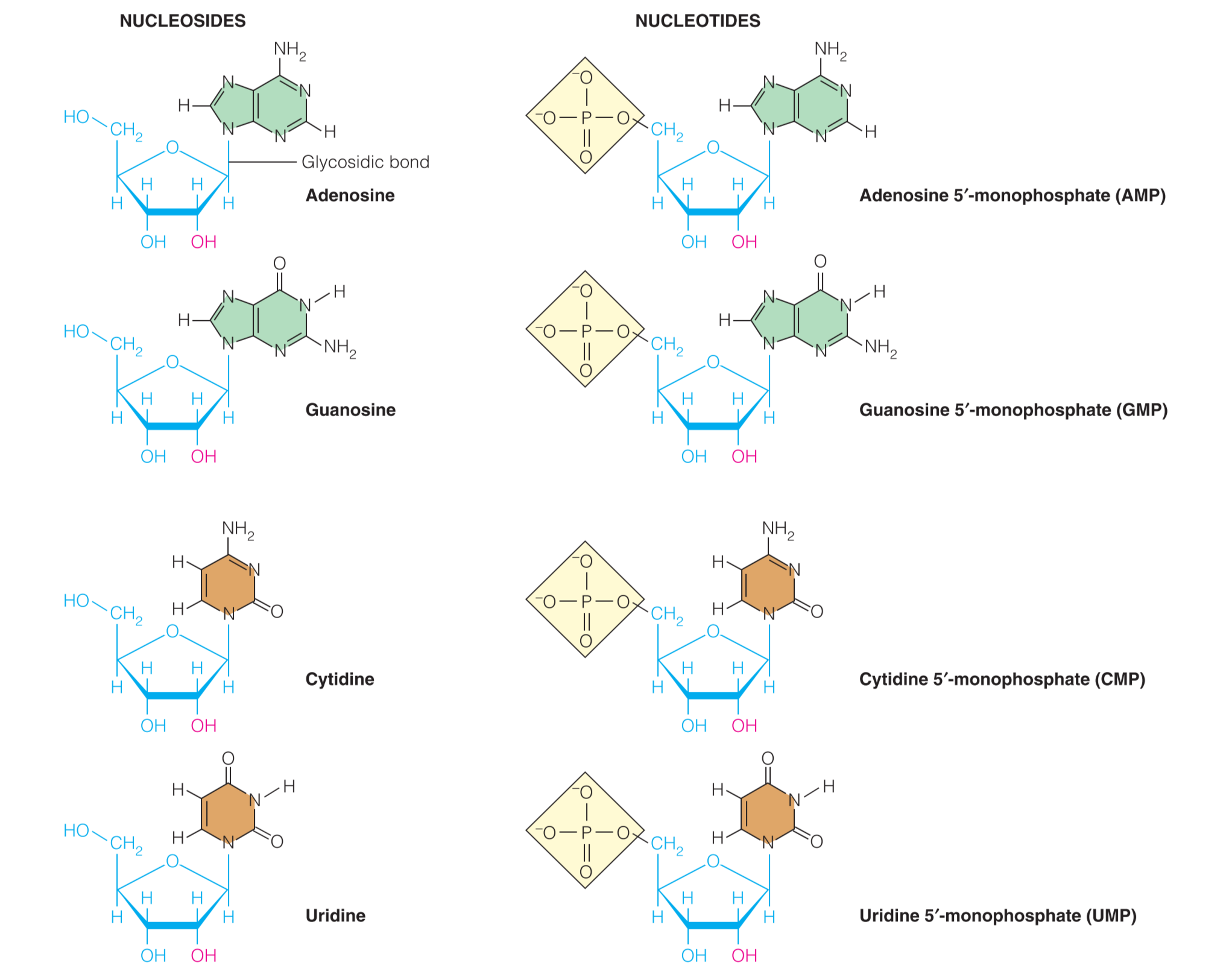
Because all of the nucleic acids may be regarded as polymers of nucleotides, they are often refered to by the generic name polynucleotides(多核苷酸). Small polymers, containing only a few residues, are called oligonucleotides(寡核苷酸).
Cyclic nucleotides
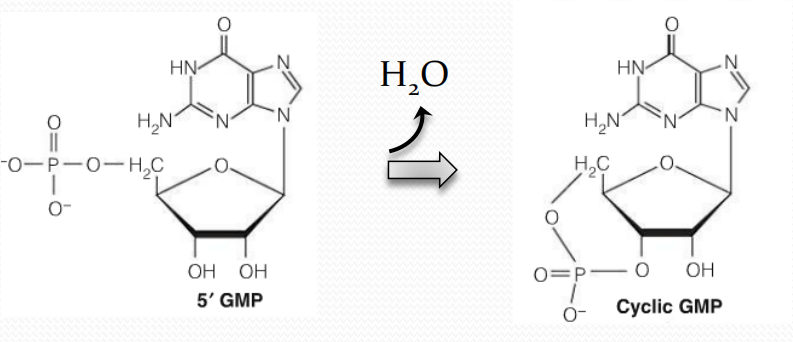
特殊的cyclic结构具有特殊的作用
如cAMP and cGMP:
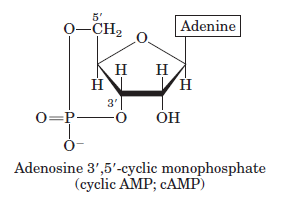
Secondary messangers in signal transduction
Properties of the Nucleotides
1. Nucleotides are strong acids
Nucleotides are strong acids; the primary ionization of the phosphate occurs with a pKa of approximately 1.0. Both secondary ionization of the phosphate and protonation(质子化) or deprotonation of the amino groups on the bases within the nucleotides can be observed at pH values close to neutrality
1 | |
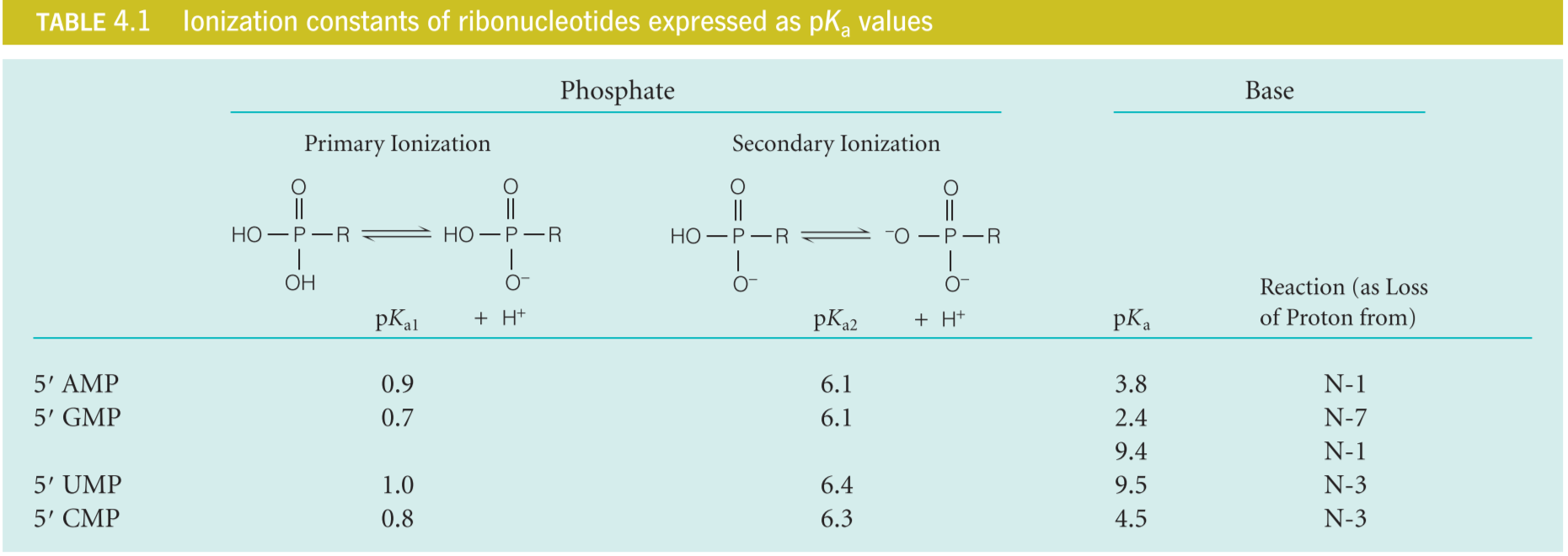
2. Tautomerization(互变异构化) of the bases
Tautomeric forms: differing in the location of hydrogen atoms and double bonds
The bases are also capable of conversion between tautomeric(互变异构的) forms.
Tautomeric forms, or tautomers,are structural isomers differing only in the location of their hydrogen atoms and double bonds.
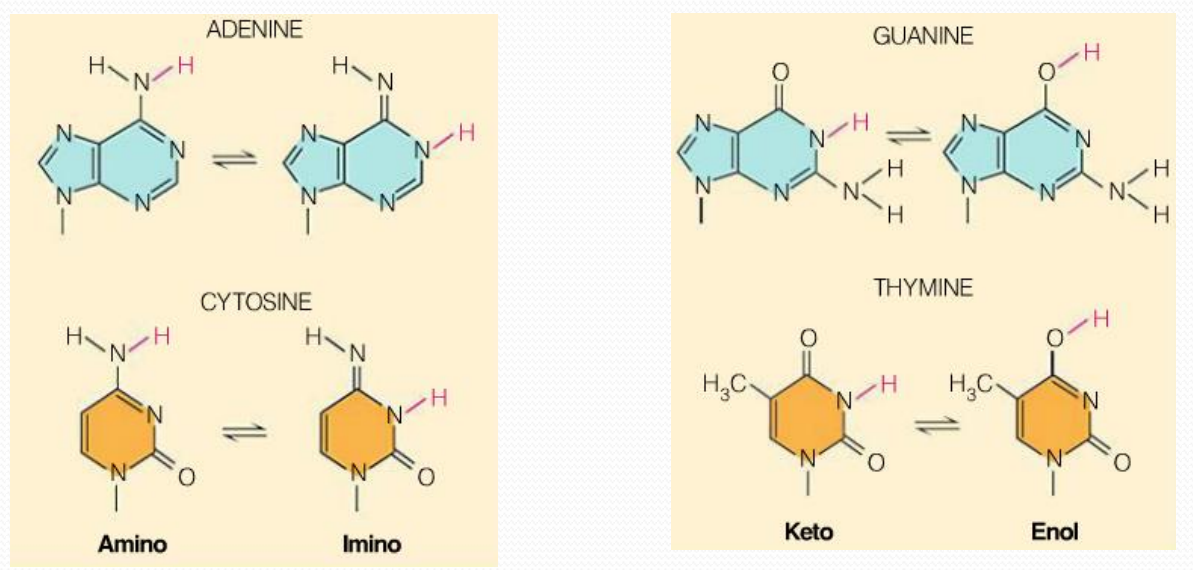
3. UV absorption
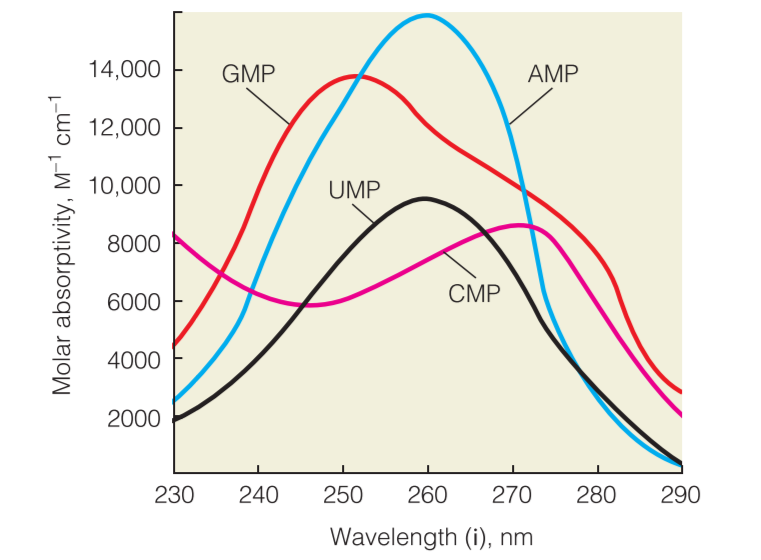
因为共轭双键存在于碱基的ring结构中,所以nucleotide具有一定强度的UV absorption.
This is a quantitative measurement of concentration of necleic acids
DNA can be damaged by absorbing UV light :
- Natural or artificial induced mutations
- Skin Cancer
Formation of polynecluotides
Composed of four different nucleotides
A, T, C, G in DNA
A, U, C, G in RNA
Nucleotides are linked via phosphodiester bonds
1. Direction
Directional linkage
5’ end and 3’ end
5’ $\rarr$ 3’
Sugar residues
2. dehydration and hydrolysis


整个过程的$\Delta G ^{\circ}$为$+25kJ/mol$,因此不是thermodynamically favored reaction.
3. Stability and Formation of the Phosphodiester Linkage
Metastability(亚稳态)
metastability:持续时间较长的激发态被叫做亚稳态(metastable)
Metastable compounds are thermodynamically favored to break down, but do so only very slowly unless the reaction is catalyzed.
酶不改变反应的方向,改变反应的速度
Polynucleotides are metastable compounds
- The hydrolysis is extremely slow under the conditions existing in living cells
DNA is stable in living cells
- Serve as genetic information
例:(核苷酸聚合)

Formation of polynecluotides
(1) Polymerase(聚合酶) and Nucleases(核酸酶)
The formation of DNA or RNA is catalyzed by enzyme called polymerase
- DNA polymerase
- RNA polymerase
The hydrolysis of DNA or RNA is catalyzed by enzyme called nuclease
Deoxyribonuclease (DNase)
Ribonuclease (RNase)
(2) Environment conditions
DNA is much more stable than RNA
RNA is easy to be degraded in certain conditions
- alkaline conditions
DNA forms more stable double helical structures
RNase exists in our skin and hair
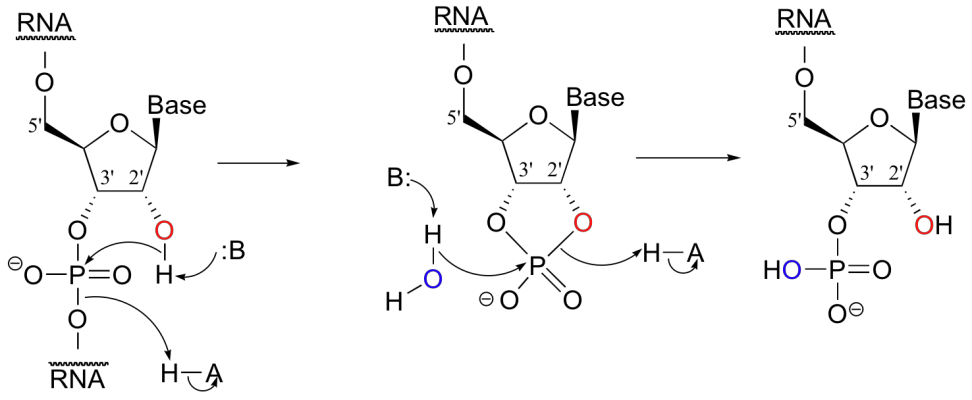
二、The Primary Structure of Nucleic Acid
A polynucleotide chain has a sense* or *directionality. The phosphodiester linkage between monomer units is between the carbon of one monomer and the carbon of the next. Thus, the two ends of a linear polynucleotide chain are distinguishable. One end normally carries an unreacted phosphate, the other end an unreacted hydroxyl group.
A polynucleotide chain has individuality, determined by the sequence of its bases—that is, the nucleotide sequence. This sequence is called the primary structure (一级结构) of that particular nucleic acid.
The main importance of primary structure, or sequence, is that genetic information is stored in the primary structure of DNA. A gene is nothing more than a particular DNA sequence, encoding information in a four-letter language in which each “letter” is one of the bases.
三、The Secondary And Tertiary Structure of Nucleic Acids
The Double Helix
We refer to such regular folding in polymers as secondary structure(二级结构).
In the Watson–Crick model, the hydrophilic phosphate–deoxyribose backbones of the helix were on the outside, in contact with the aqueous environment, and the base pairs were stacked on one another with their planes perpendicular to the helix axis.
The model also shows that although the bases are inside, they can be approached through two deep spiral grooves called the major grooves(大沟、深沟) and minor grooves(小沟)
The pairing distance = 1.08 nm
1. The force that exists in DNA molecular
DNA分子中包括了所有 noncovelent bonds:
Hydrogen bonds:Watson‐Crick base paring
van der Waals interactions:π‐π stacking between bases
1
In chemistry, pi stacking (also called π–π stacking) refers to attractive, noncovalent interactions between aromatic rings, since they contain pi bonds. These interactions are important in nucleobase stacking within DNA and RNA molecules, protein folding, template-directed synthesis, materials science, and molecular recognition, although new research suggests that pi stacking may not be operative in some of these applications. Despite intense experimental and theoretical interest, there is no unified description of the factors that contribute to pi stacking interactions.Hydrophobic interactions:Phosphate‐deoxyribose backbones (outside) and Base pairs (inside)
Charge-Charge interactions: 使得蛋白质能够与DNA分子结合,但是具有Repulsive effects,使得DNA分子更加不稳定
2. Grooves – Interact with protein molecular
蛋白质分子与DNA分子的结合部位是DNA分子的major groove
同时DNA分子主要通过氢键实现蛋白质与DNA分子的interaction:
碱基与蛋白质表面的binding site形成特异性的氢键,以此使得蛋白质可以识别当前的核苷酸
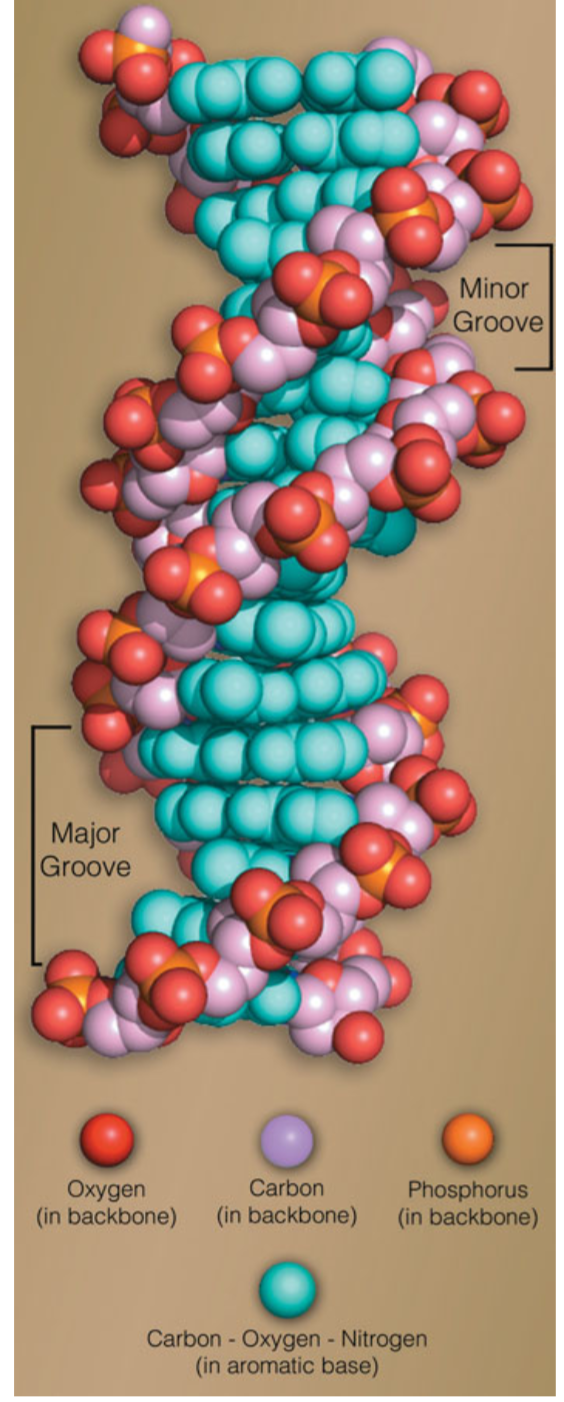
The major groove gives more direct access to the bases; the minor groove faces the sugar backbone.
3. The biological consequences
Redundancy
Two chains of a DNA are complementary to each other
Self‐replication
“A copy mechanism for the genetic material” ‐ W&C
Models of replication
Conservative
- One of two daughter duplexes is the conserved parental duplex when the other is synthesized de novo
Dispersion
- Parental material is scattered through the structures of the daughter duplexes
Semiconservative(半保留) Nature of DNA Replication
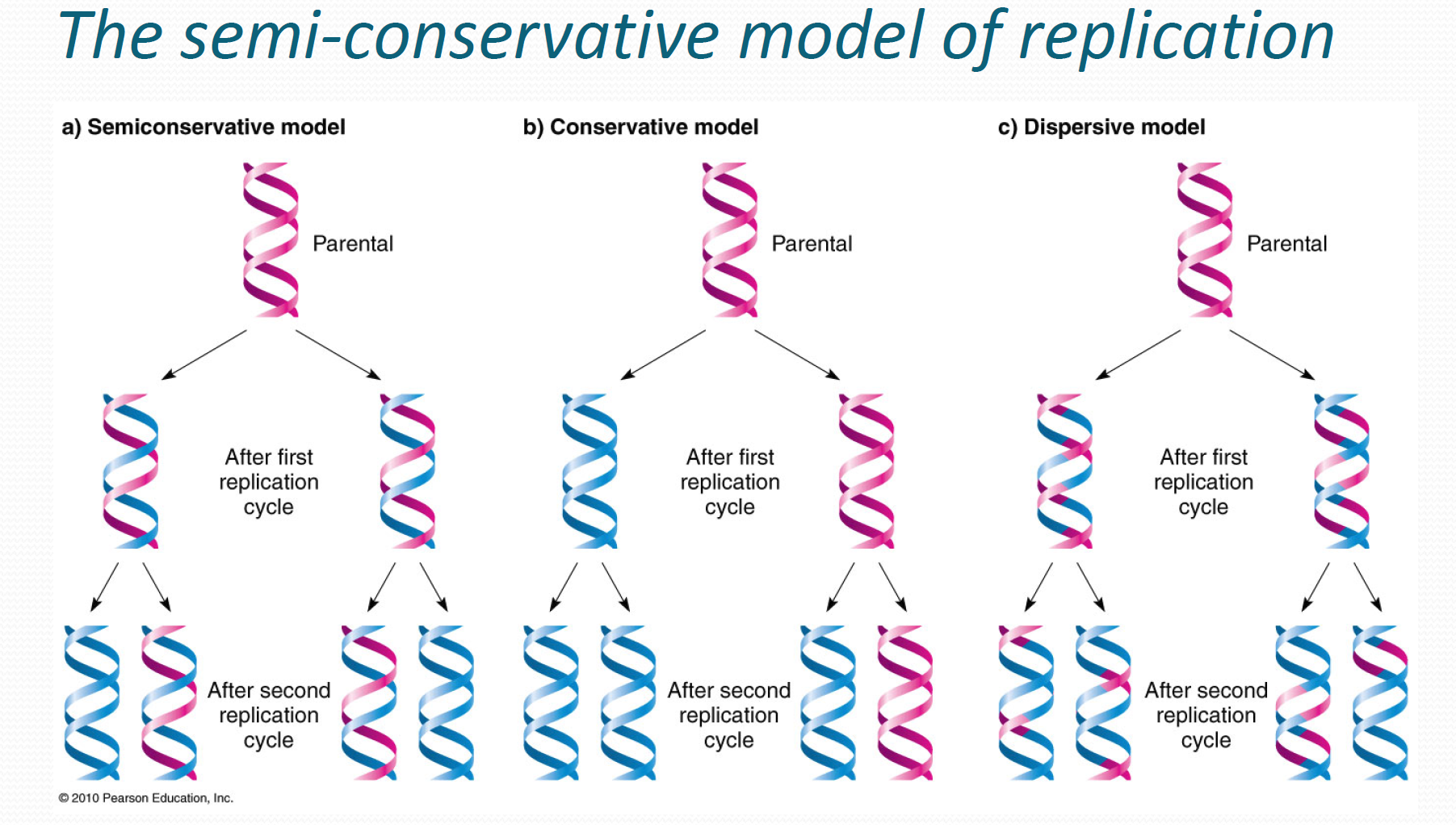
The Meselson‐Stahl experiment
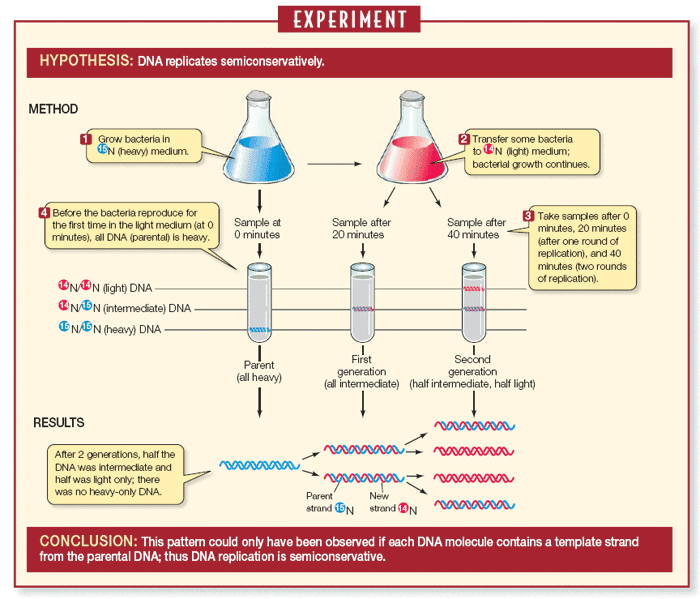
Three forms of polyneucleotide helices
Nucleic acid secondary structure is not homogeneous. It varies in response to the local sequence and can be changed by interaction with other molecules.
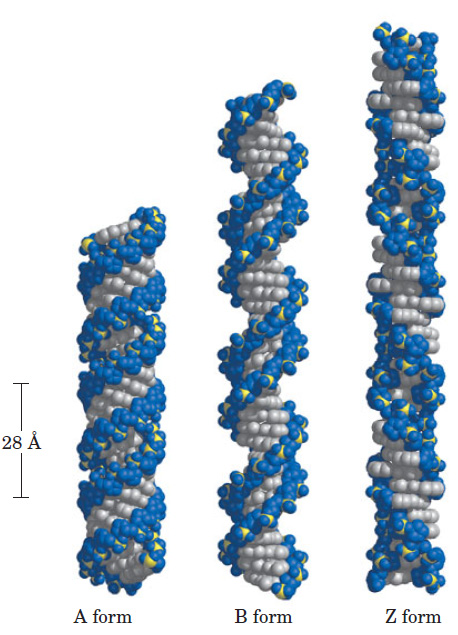
1. B form
- B form is the Waston-Crick model
- Most DNA
The B form, which is seen in DNA fibers prepared under conditions of high humidity
The B form of DNA, but not A-DNA, can accommodate(容纳) a spine of water molecules lying in the minor groove. The hydrogen bonding between these water molecules and the DNA may confer stability to the B form. According to this hypothesis, when this water is removed (as in fibers at low humidity), the B form becomes less stable than the A form.
2. A form
- Double strand RNA
- DNA/RNA hybrids
DNA fibers prepared under conditions of low humidity have a different structure, the so-called A form
Double-stranded RNA molecules always form the A structure, and so do DNA–RNA hybrid molecules, which are formed by the pairing of one DNA strand with one RNA strand.
In the A helix the bases lie farther to the outside and are strongly tilted(倾斜的) with respect to the helix axis. The surfaces of the helices are also different. In the B helix the major and minor grooves are quite distinguishable, whereas in the A helix the two grooves are more nearly equal in width.
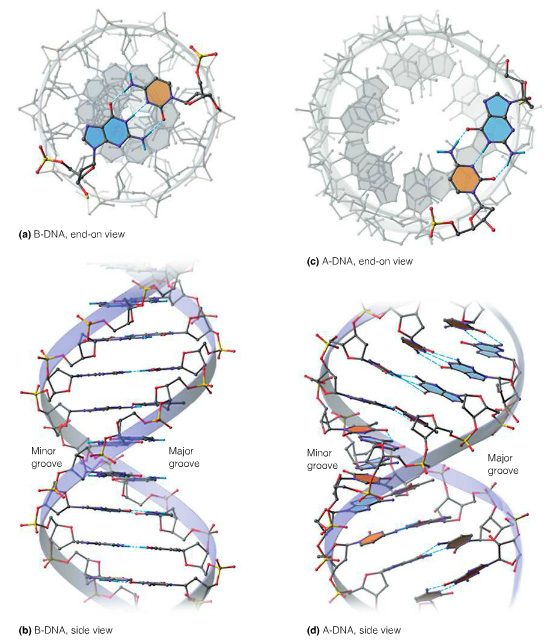
3. Z form
- Appears in some junction regions
- Left-handed helix
- requirs specific sequence(CGCGCG) and certain conditions
- Tension
- Salt: High salts concentration are needed to minimize the repulsion between the backbone phosphates
总而言之:B form是Watson‐Crick model,并且大多数DNA都是B form。在低湿度的条件下,B form会变为A form,常见于Double‐stranded RNA and DNA/RNA hybrids
Z form常常由于一些特殊的环境或者核苷酸的特殊序列导致:Specific sequences,Certain conditions(Tesion,Salt)
4. The Nuleoside oriention in A,B,Z form helix
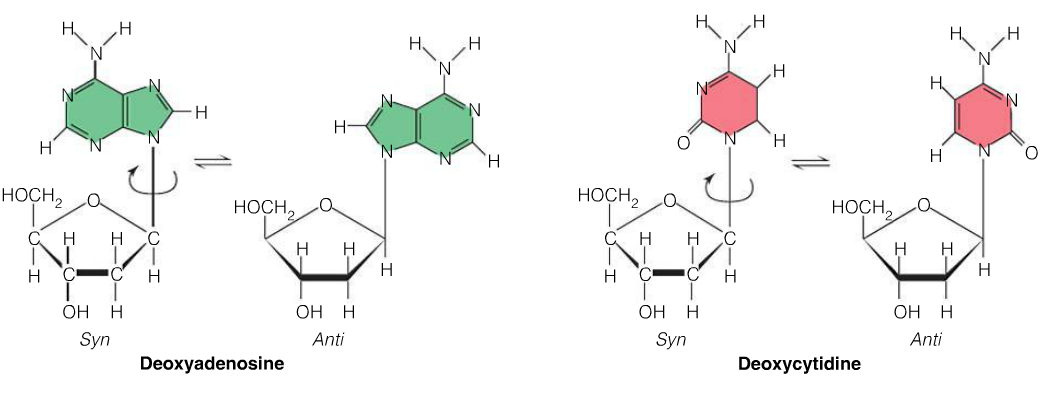
A and B form
All anti oriention
Z form
Pyrimidines(C and T)are anti
Purines (A and G)are syn
Not stable
5. B-DNA to Z-DNA
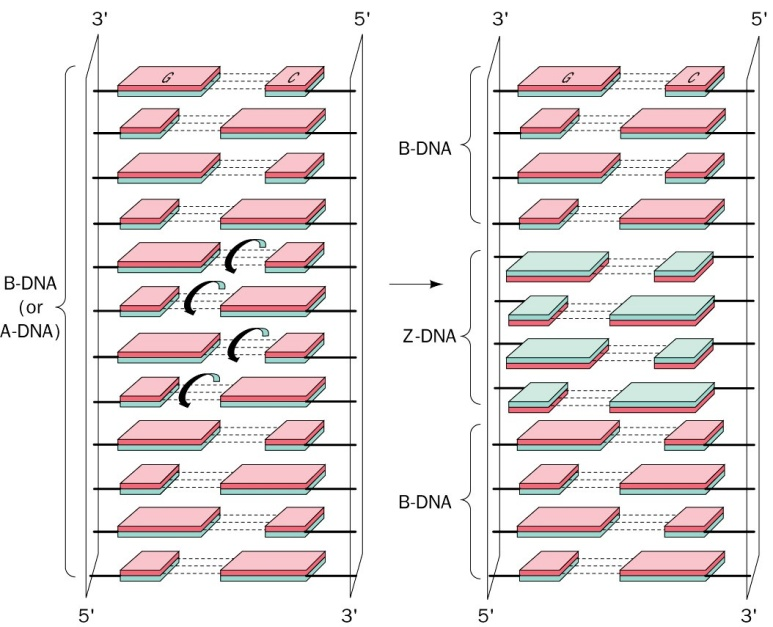
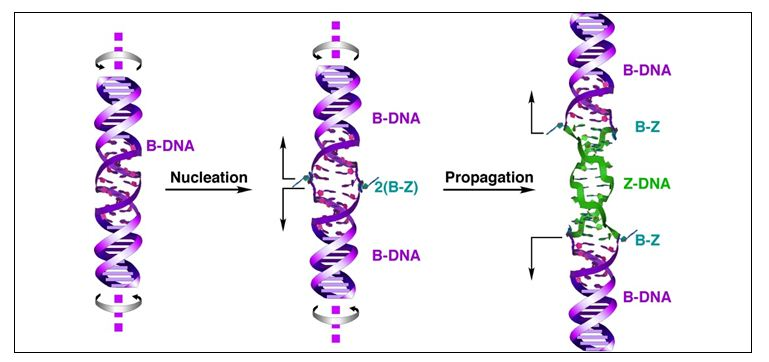
6. Structural Properties of the three helixes
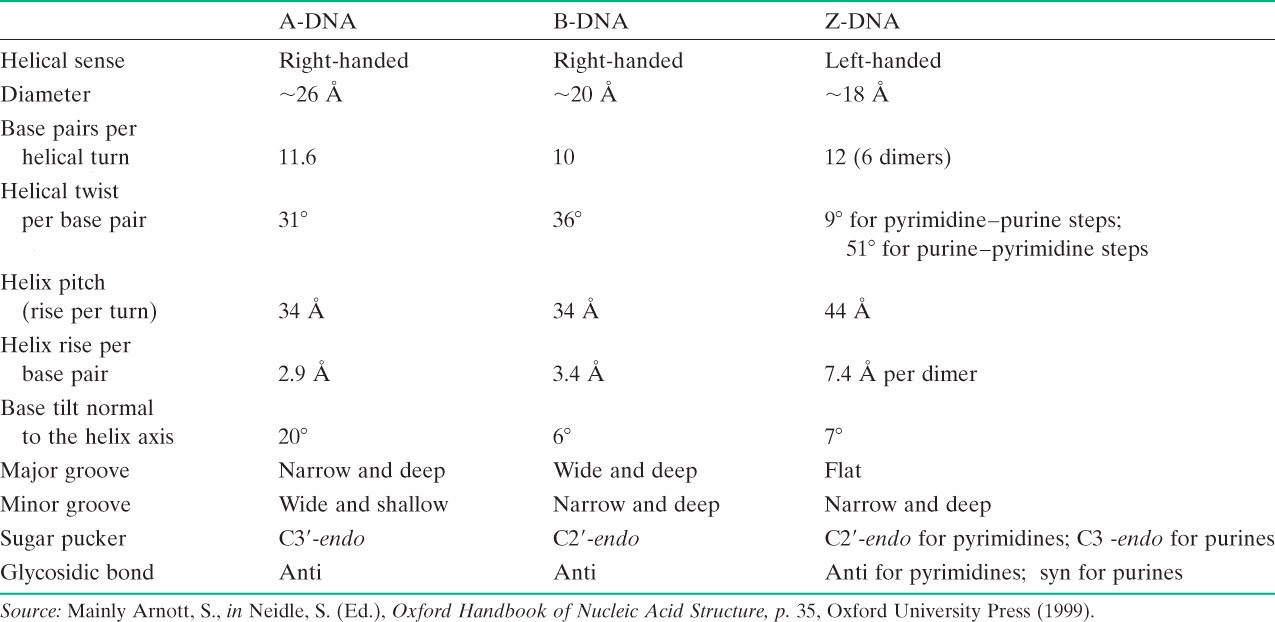
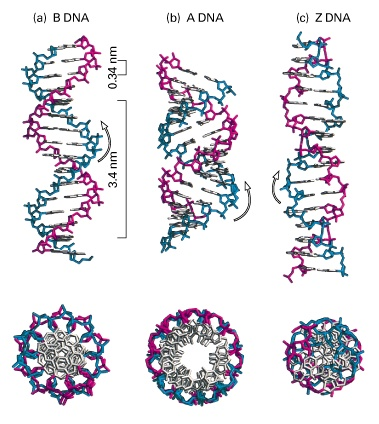
7. Sugar Pucker
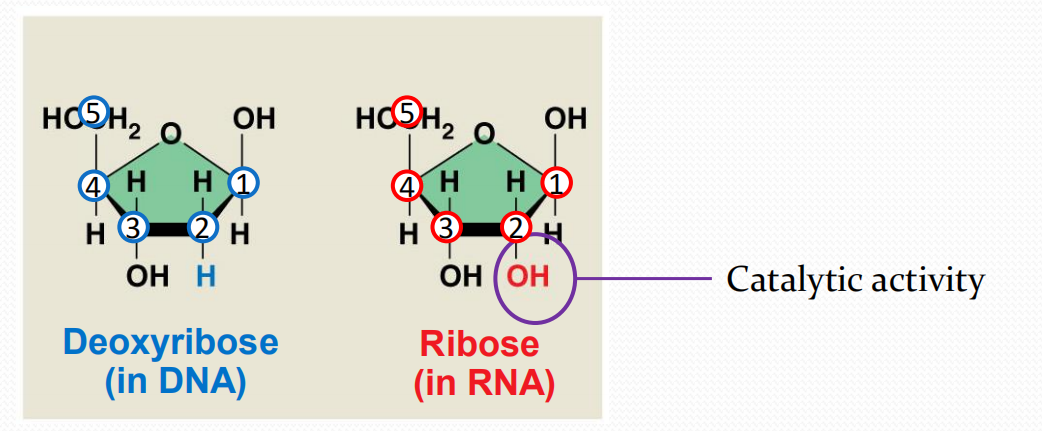
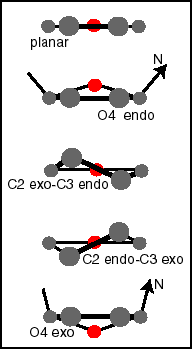
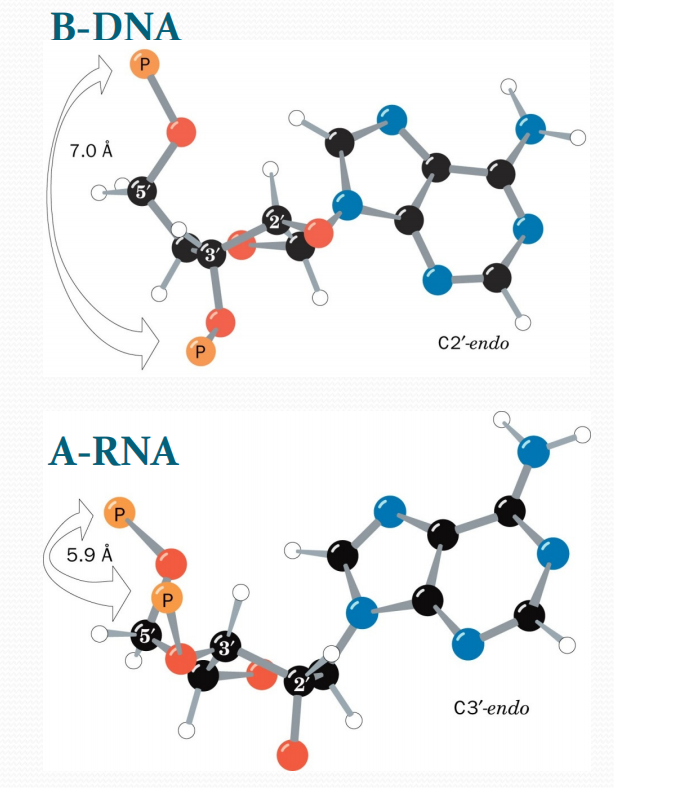
The purine bases of Z-DNA, formed for example with d(CG)3, are rotated into the syn conformation. The sugar pucker is C3′-endo.
The pyrimidine bases maintain an anti conformation. Sugar pucker is C2′-endo
Z-DNA is thus characterized by a dinucleotide repeat in which anti and syn conformations of the bases alternate in succession along the chain.
DNA and RNA Molecules in Vivo
(1)Circular DNA and Supercoiling
Three-dimensional structure, such as supercoiling, that involves a higher-order folding of elements of regular secondary structure is called the tertiary structure(三级结构) of a polymer.
Most naturally occurring circular DNA molecules have left-handed superhelical twists, but it is possible to form DNA molecules with right-handed superhelicity. By convention, we call right supercoiling positive and left supercoiling negative.
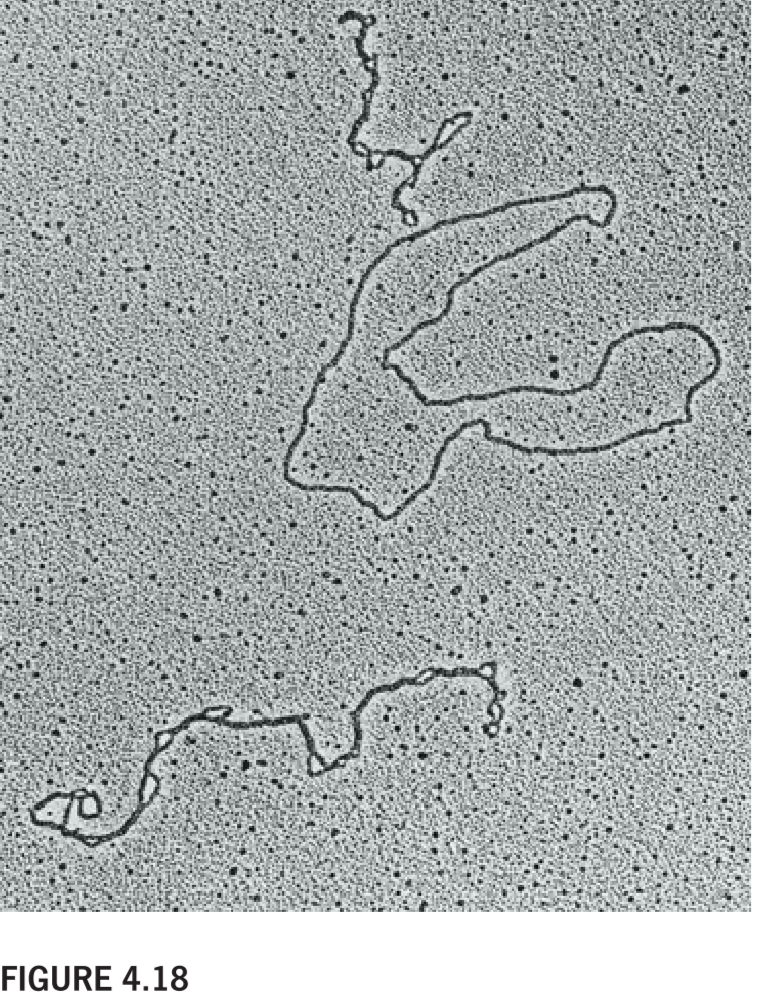
The DNA molecules shown in Figure 4.18 differ only in their topology, meaning that they can be superimposed only by breaking bonds; therefore, they are called topoisomers(拓扑异构体). Topoisomers can be interconverted only by cutting and resealing the DNA. Cells have enzymes capable of doing this. These enzymes are called topoisomerases(拓朴异构酶), and they regulate the superhelicity of natural DNA molecules.
(2)Structure of Single-Stranded Polynucleotides
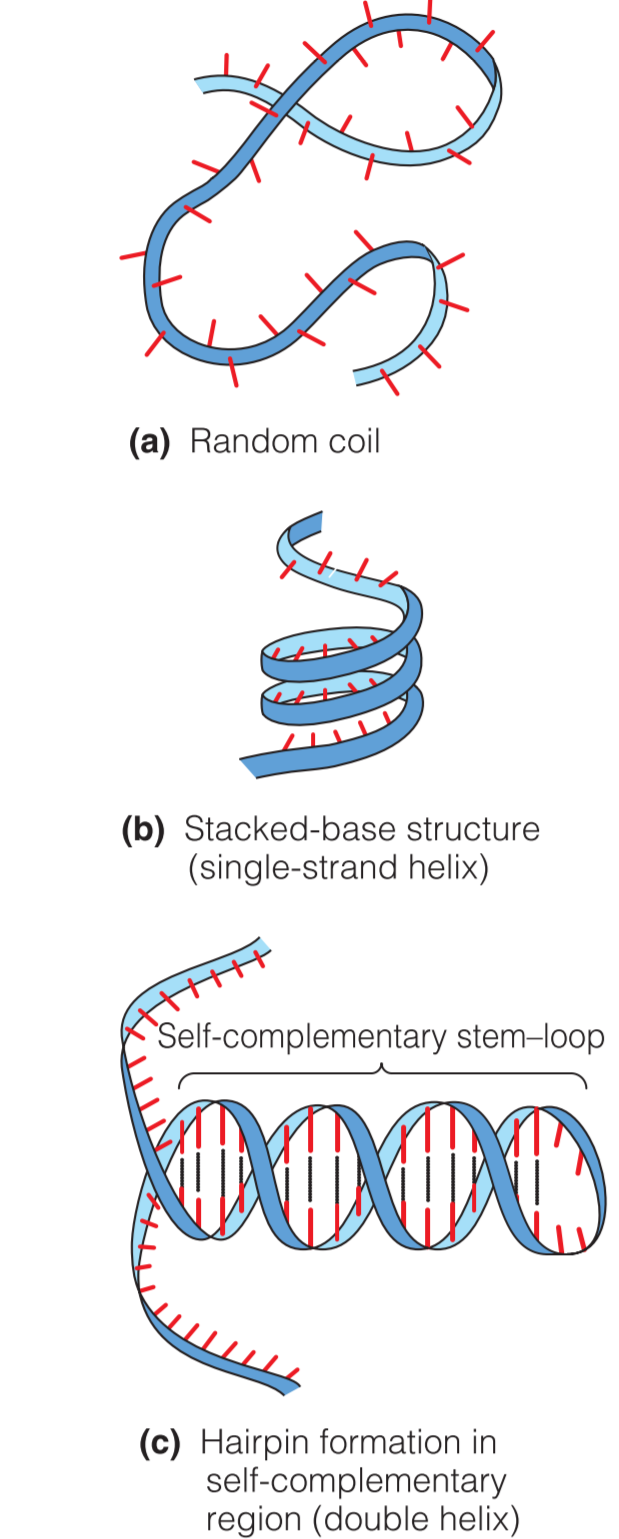
One Example of Single-strand polynucleotide is the tRNA:
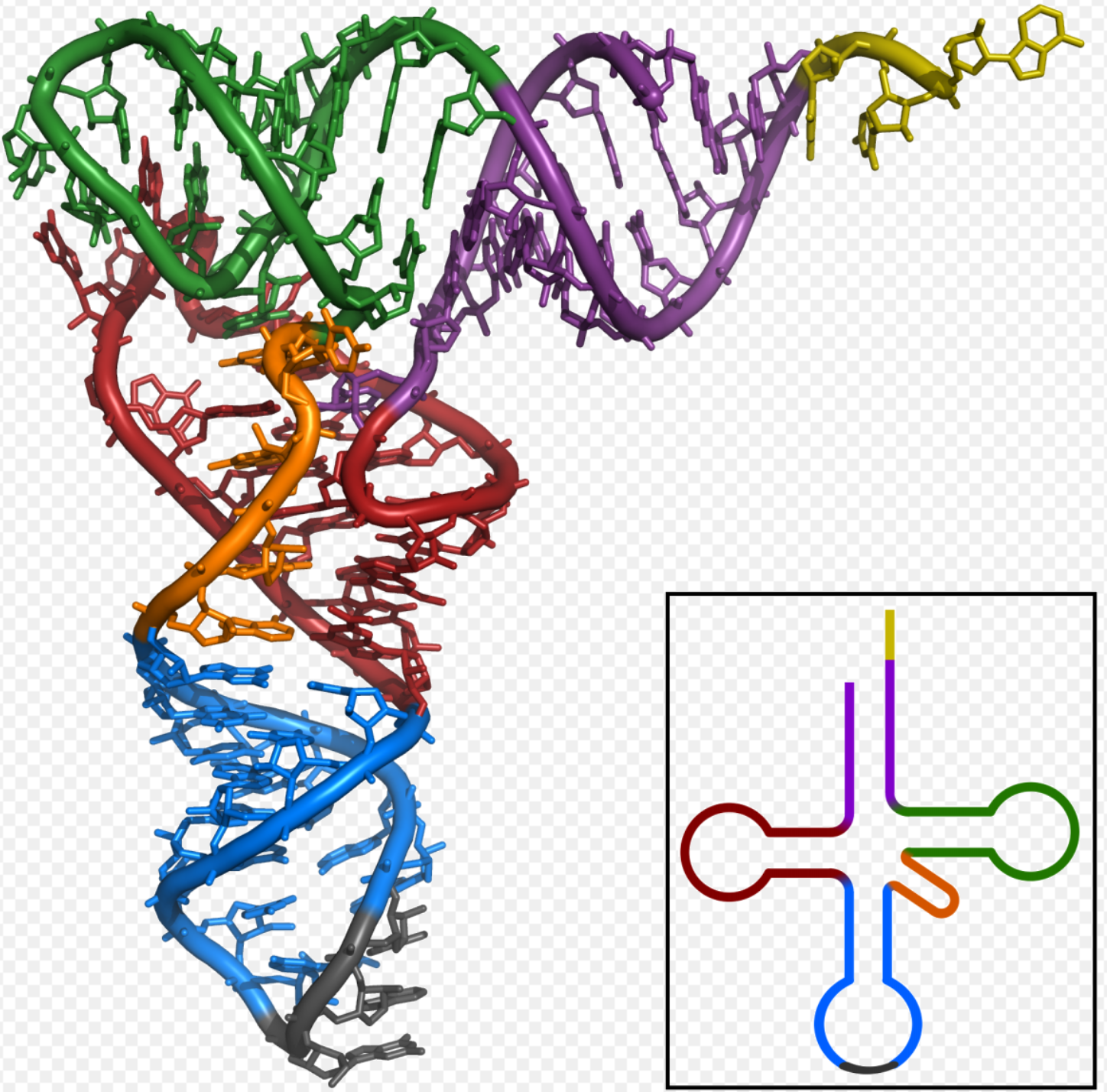
四、The Biological Functions of Nucleic Acids
Genetic Information Storage: The Genome
Replication: DNA to DNA
The replication of DNA is accomplished by a complex of enzymes, acting in concert like a finely tuned machine.
Each enzyme complex, or replisome(复制体), centered on a protein called DNA polymerase(DNA聚合酶), has multiple functions.
each of the parental DNA strands serves as a template, specifying the sequence ofa daughter strand. DNA polymerase adds nucleotides, one at a time, to the growing daughter strand, which can be considered a primer to which nucleotides are added as the daughter DNA strand grows from its 5‘ end toward its 3’ end
Transcription: DNA to RNA
Translation: RNA to Protein
五、Plasticity of Secondary and tertiary DNA Structure
Changes in Tertiary Structure: A Closer Look at Supercoiling
(1)Twist (T)
Measure of the helical winding(弯曲) of the DNA strands around each other
(2)Writhe (W)
The number of superhelical turns
Measure of the coiling of the axis of the double helix
(3)Linking number (L)
The number of crosses a single strand makes across the other
$$
L = T+W
$$
Right handed supercoiling = negative supercoiling (underwinding)
Left handed supercoiling = positive supercoiling (overwinding)
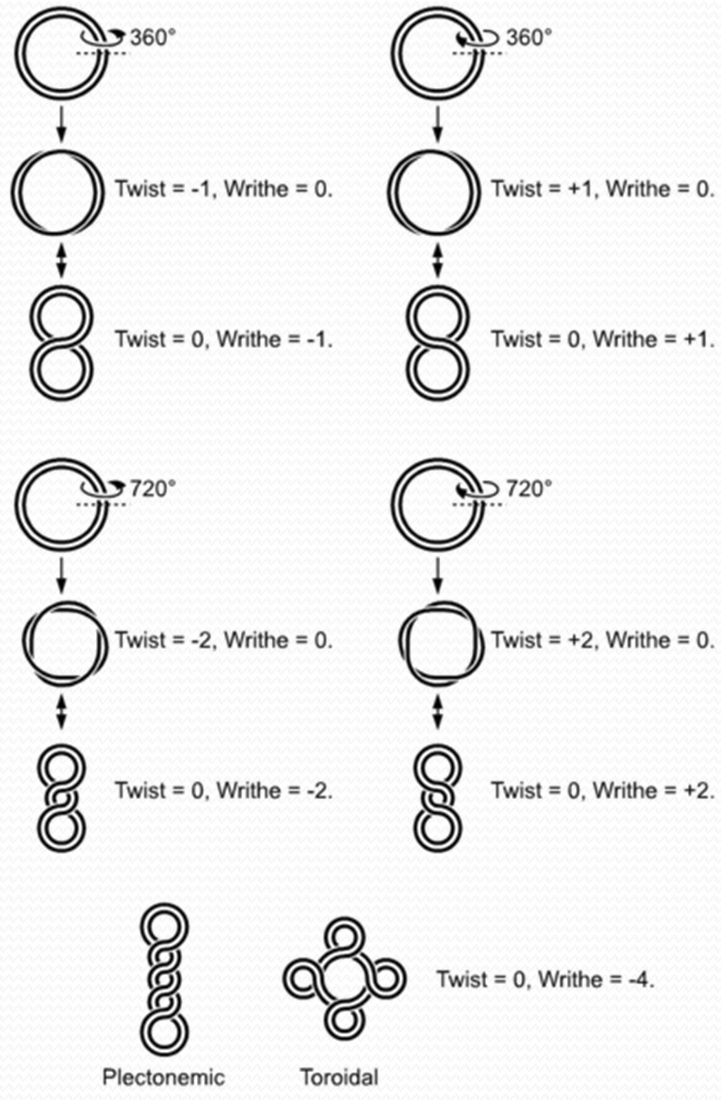
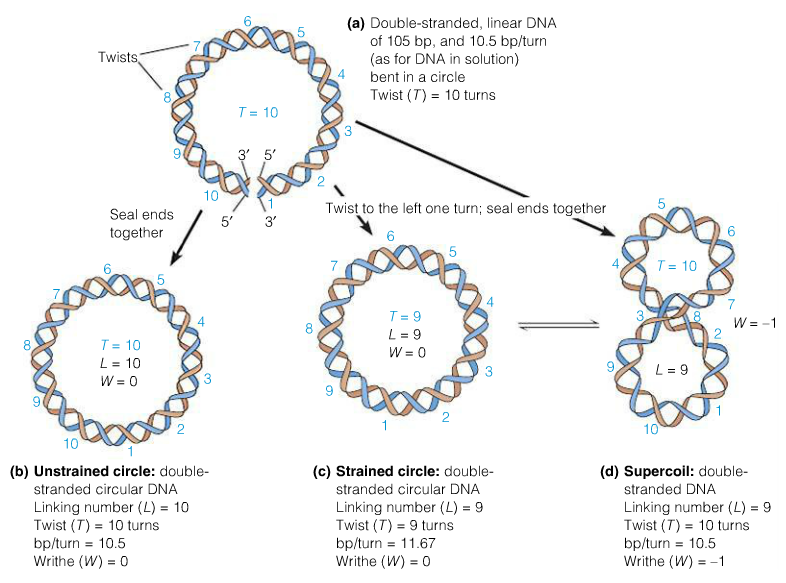
topoisomerase 拓扑异构酶

Unconventional Secondary Structures of DNA
Most ofthe DNA and RNA in cells can be described as having one ofthe three secondary structures—random coil (which is really a lack of secondary structure), B form, or A form.
Function of Supercoils
The DNA of most organisms is negatively supercoiled
- negative W
DNA/RNA synthesis
- Generation of supercoils by polymerases
Regulation of gene expression
- by the special effects of supercoiling torsion(超螺旋扭转) of DNA:
- Local melting
- Z-DNA formation
- H-DNA formation
- Cruciform extension (十字形延伸)
Condense DNA during nuclear division events
- Mitosis or meiosis
DNA packing in bacteria
DNA packing in eukaryotes
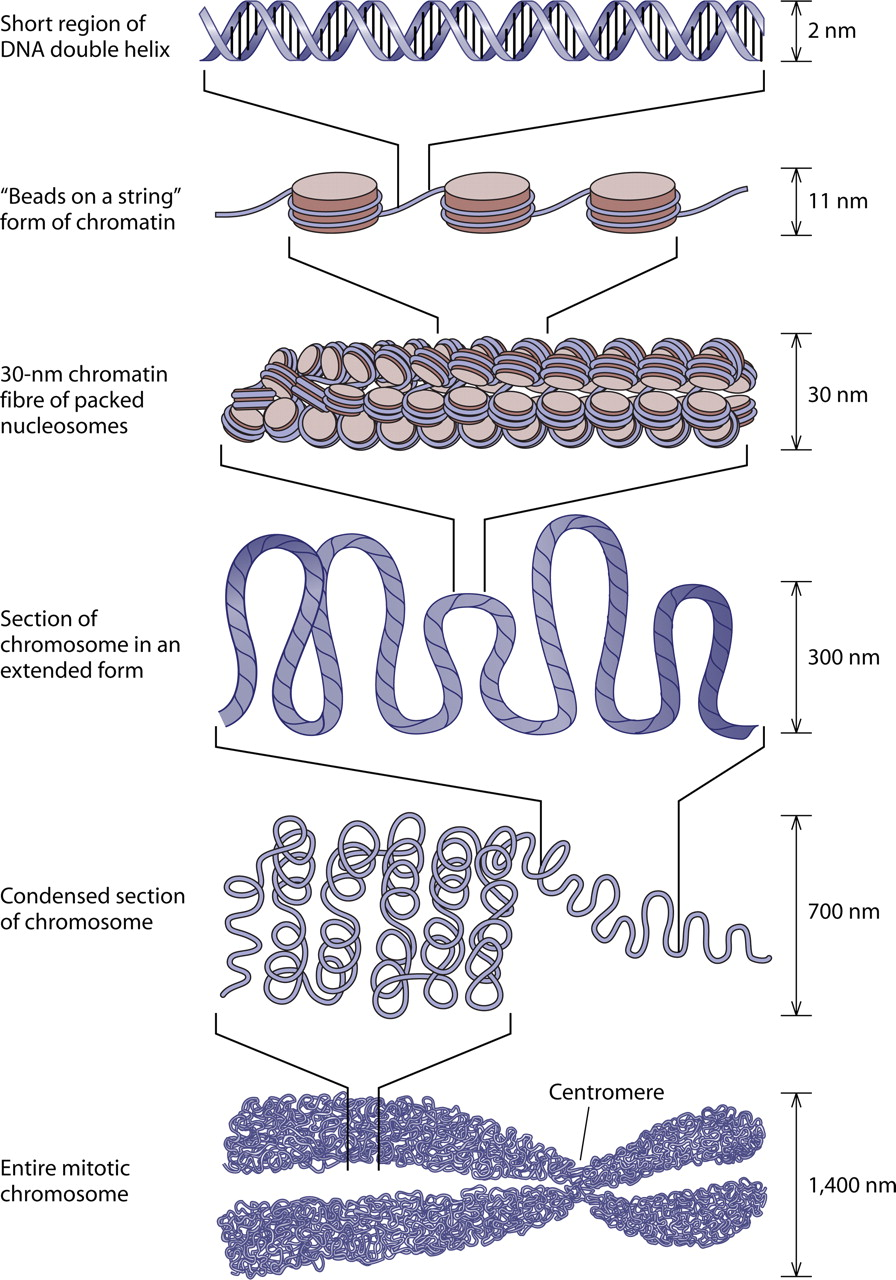
(1)Left-Handed DNA (Z-DNA)
in polynucleotides, two most stable orientations of the bases with respect to their deoxyribose rings. They are called syn and anti:
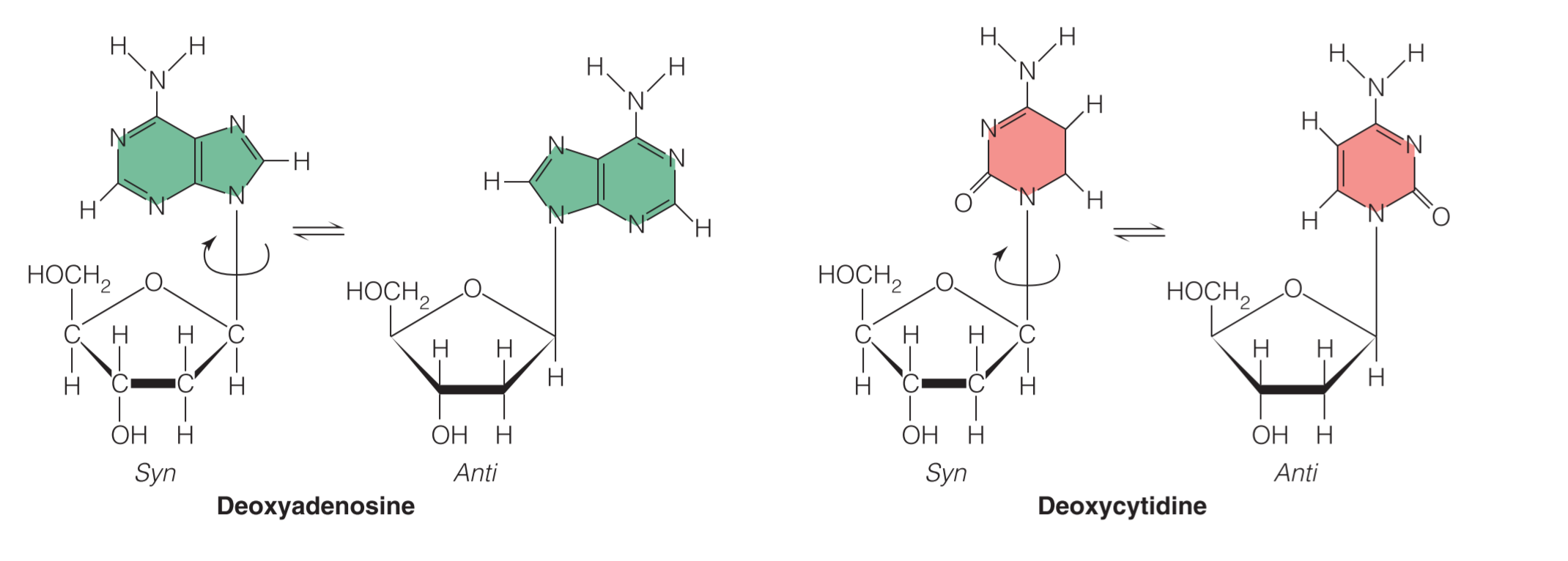
In both A- and B-form polynucleotides, all bases are in the anti orientation. In Backbone Bases Z-DNA, however, the pyrimidines are always anti, but the purines are always syn.
Because Z-DNA is most often found in polynucleotides with alternating purines and pyrimidines in each strand (such as that shown earlier), the base orientations will alternate.
B-DNA to z-DNA
因为Z-DNA中,磷酸基团之间靠得更近,因此也使得Z-DNA处于较高能的状态,所以Z-DNA相比于B与A-DNA更不稳定
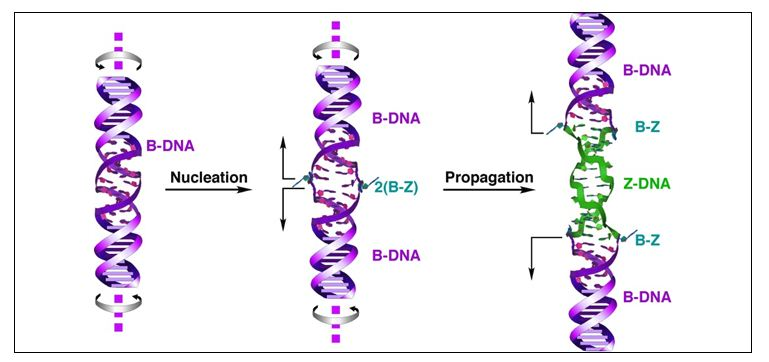
The Comparision of A, B and Z-DNA
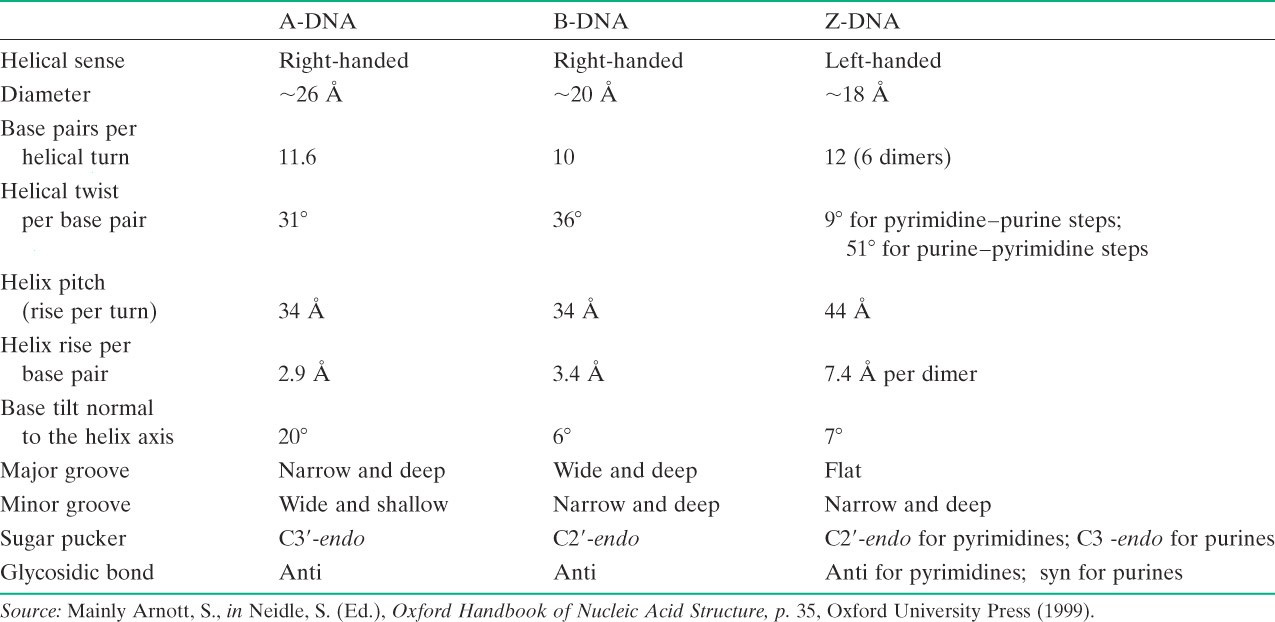
(2)Hairpins and Cruciforms
Hairpins 发夹形 and Criciforms 十字形
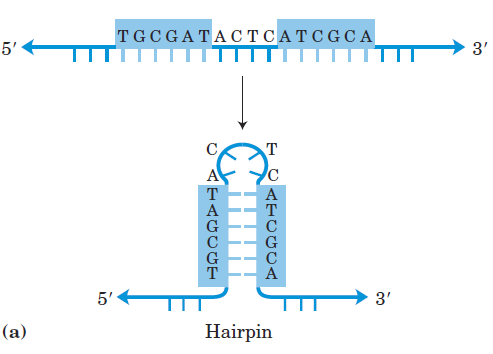
Double hairpins, often called cruciform (cross-like) structures, can be formed in some DNA sequences. To form this structure, the sequence must be palindromic(回文的).
(3)Triple Helices and H-DNA
Hoogsteen-type base pairing
deoxy triplets like T - A - T and C^+^ - G - C (where C^+^is a protonated cytosine), which is in addition to the normal watson-click base pairing.
Triple Helices
三螺旋的厂商也是因为Hoogsteen-type base pairing
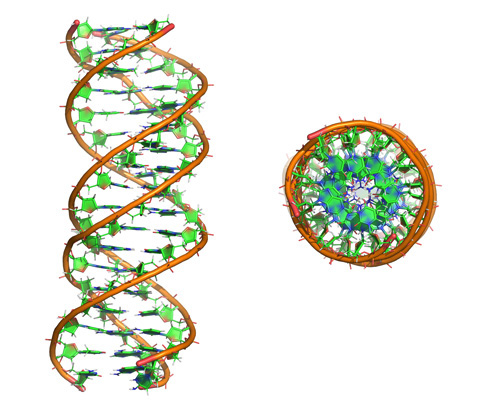
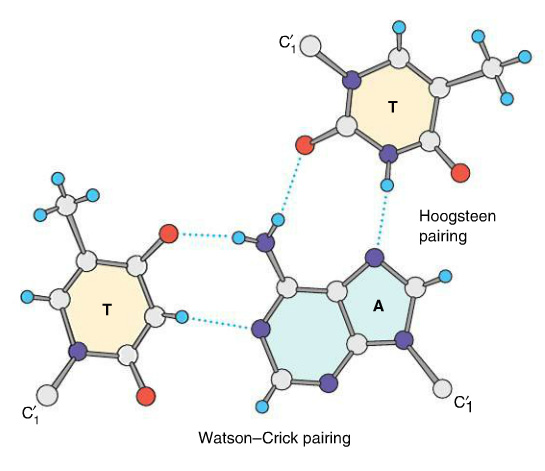
H-DNA

H-DNA是一种可以形成三螺旋的结构,需要一条链全为嘧啶,一条链全为嘌呤
(4)G-Quadruplexes G-四链体
A G-quadruplex structure can form from one DNA strand, as shown, or from as many as four strands.
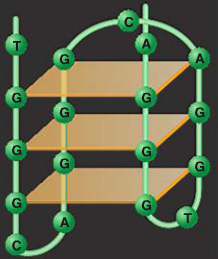
G-quadruplexes actually form in living cells and exist in telomeres(端粒), special sequences at the ends of linear eukaryotic chromosomes
Also exists in promoters (transcriptional control sites)
(5)An Unexpected Primary Structure Modification: DNA Phosphorothioation(硫酸酰化)
在部分细菌中,an enzyme system converts a phosphate group in DNA to a phosphorothioate.
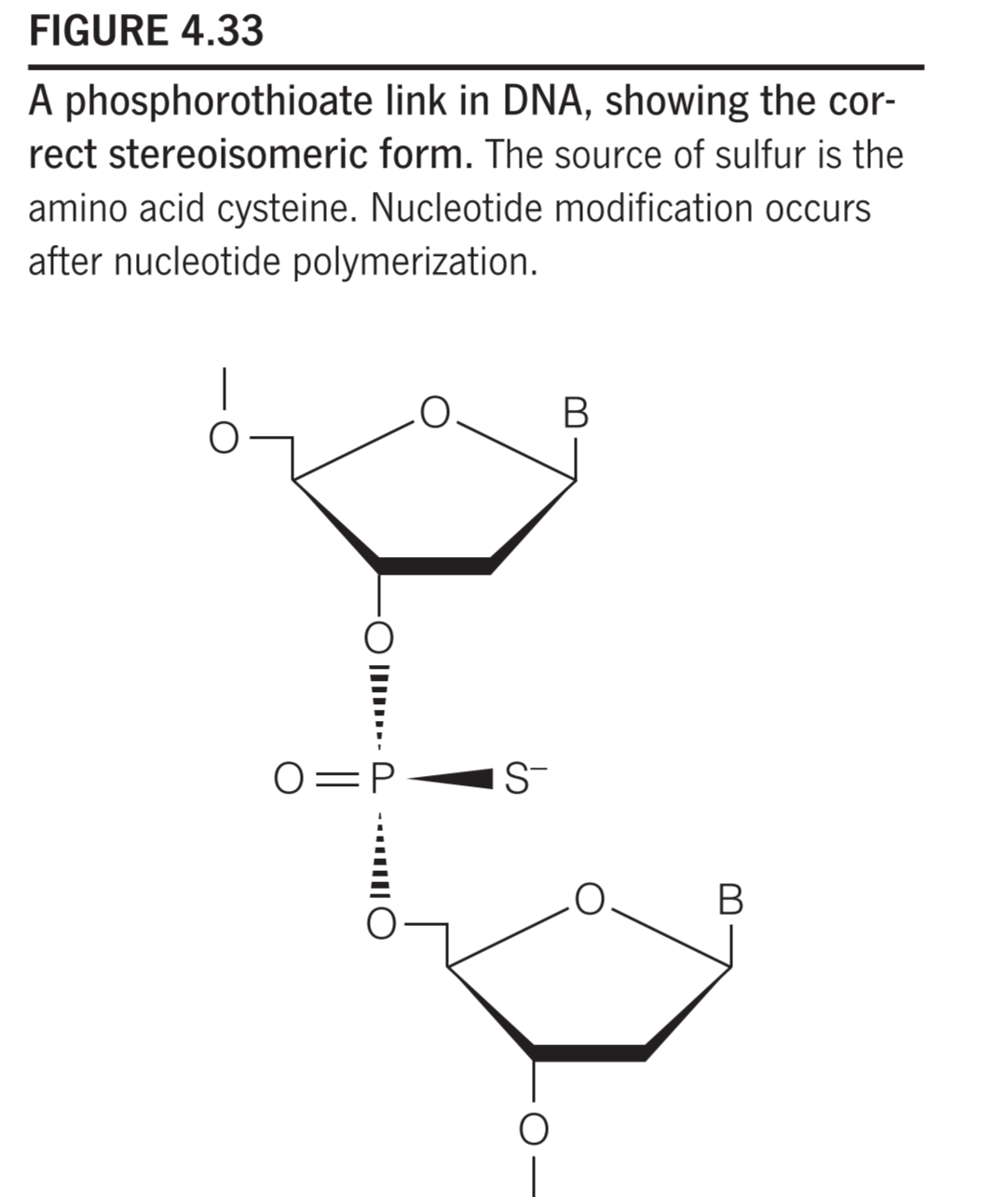
but it might confer resistance to some foreign invaders, such as bacteriophages, which could degrade
unmodified DNA.
六、Stability of Secondary and Tertiary DNA Structure
The Helix-to-Random-Coil Transition: Nucleic Acid Denaturation
DNA and RNA sometimes must not be too stable because important biochemical processes—DNA replication and transcription
When it extends over large regions, this loss of secondary structure is called denaturation.
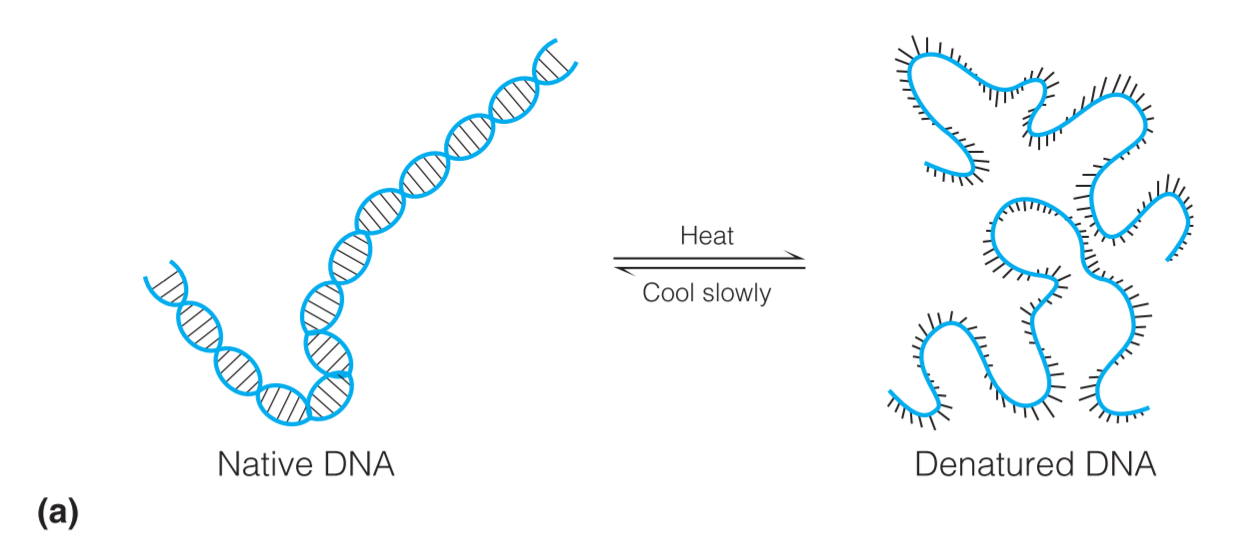
1. The Denaturation
$$
T_m = \frac{\Delta H}{\Delta S}
$$
$T_m$ depends on the (C+G)/(A+T) ratio
Superhelical Energy and Changes of DNA Conformation
七、RNA structure
RNA is mainly a single-stranded polynucleotide
- transfer RNA (tRNA)
- messenger RNA (mRNA)
- ribosomal RNA (rRNA)
- small interfering RNA (siRNA)
- micro RNA (miRNA)
- small nuclear RNA (snRNA)
Secondary structures
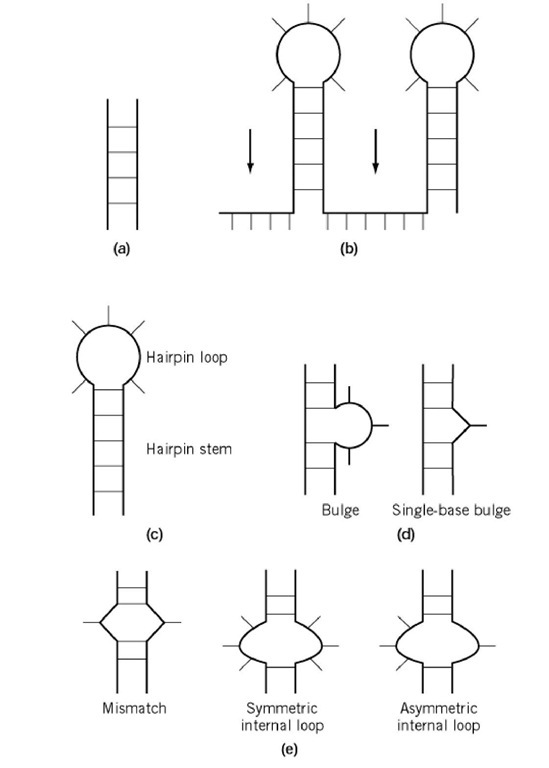
八、Other Functions of Nucleic Acids
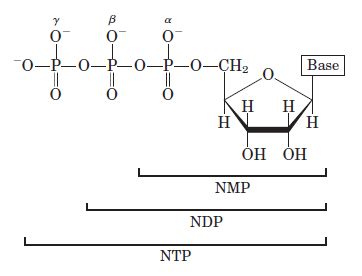
ADP/AMP
- Components of enzyme cofactors
ATP
Providing energy
Protein modification
GTP/GDP
Involved in regulation of cytoskeleton by activating or inhibiting GTPases
Providing energy in translation elongation (GTP)
cGMP/cAMP
- Secondary messengers in signal transduction
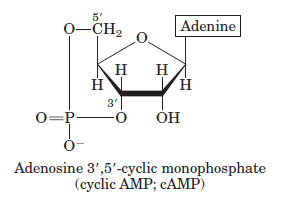
九、Biochemical techniques About Nucleic Acid
Molecular cloning
Techniques used to assemble recombinant DNA molecules and to direct their replication within host organisms
Gene regulation
Exogenous(外生的,外成的,外因的) protein expression (recombinant proteins)
1. Technique Involved
Polymerase chain reaction (PCR)
PCR: amplification of target DNA fragments
Transformation
DNA purification
DNA processing
Restriction endonuclease
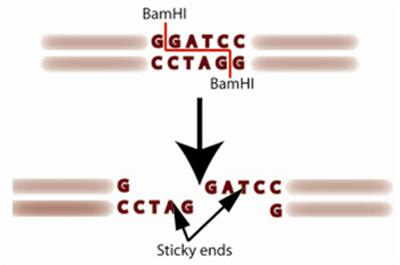
(1) Plasmid

(2) DNA ligase
